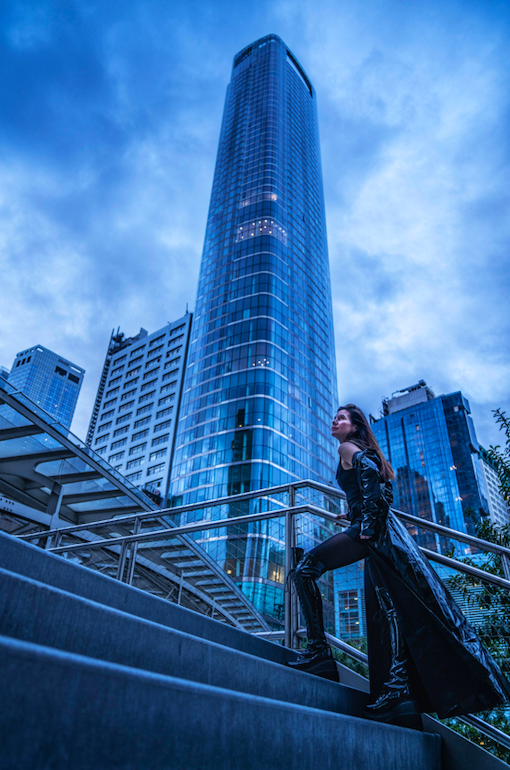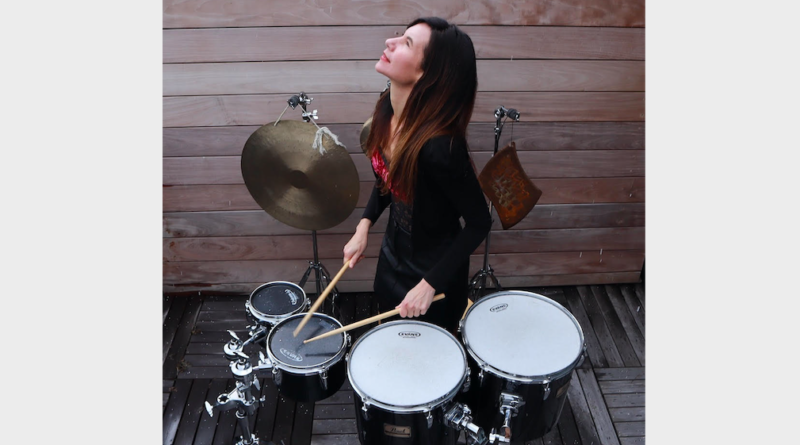INTERVIEW: Lisa Pegher to lead percussive journey into the heart of AI
Photo: Lisa Pegher is a solo drummer whose new piece is called A.I.RE. Photo courtesy of the artist / Provided by AMT PR with permission.
While the world gives pause over the ethical implications of artificial intelligence (AI), percussionist Lisa Pegher is testing out the limits of the advanced technology and see how it might inform her chosen art form. On Friday, May 17, the drummer will perform A.I.RE, a new piece that follows a percussive journey from acoustic sounds to electronic beats to eventual AI takeover. Audiences can experience A.I.RE, which stands for Artificial Intelligence Rhythm Evolution, at Manhattan’s DiMenna Center for Classical Music, where Pegher will be joined by the music collective ICEBERG New Music.
This particular project began when Pegher commissioned ICEBERG New Music to create A.I.RE, which promises a blending of classical music, metal, EDM and other styles, many of them generated by AI, according to press notes. To achieve these sounds, many different instruments will be utilized, including the kalimba, balafon, bongos, vibraphone, marimba, glockenspiel and midi boards.
Pegher is an accomplished solo drummer who has performed with some of the world’s top orchestras, including Orchestré Symphonique de Trios Rivieres in Canada, Mulhouse Orchestré France, the Thailand Philharmonic, Boston Modern Orchestra Project, Symphoria, Reading Symphony, Peninsula Festival Orchestra, Annapolis Symphony, Pittsburgh New Music Ensemble, Mission Chamber Orchestra, Pittsburgh Symphony Orchestra, Puerto Rico Symphony Orchestra and New Jersey Symphony Orchestra, among others.
Recently Pegher exchanged emails with Hollywood Soapbox to describe what audiences can expect at A.I.RE. Questions and answers have been slightly edited for style.
What can audience members expect from A.I.RE? It sounds like a unique evening.
This program, known as A.I.RE, stands for A. (Artificial) I. (Intelligence) R. (Rhythm) E. (Evolution), and it is a collaborative program between myself, Lisa Pegher, as percussion soloist; my portrayed alter ego character Magenta-Z; the composers of the ICEBERG New Music collective; and visual multimedia artist Kat Zhang (aka The Poet Engineer). The program invites listeners to search for connections between music and technology as well as humans and machines through the performance of percussion, electronics, live processing and generative AI. Over the course of the show, I lead the audience through 11 new works that slowly evolve and intertwine the incorporation of technology; machine learning; artificial intelligence; and its ability to influence, control and eventually form a symbiotic relationship with the performer.
How long have you been developing this piece?
It’s more of an overarching show than one piece, even though it is meant to be experienced in a more holistic thematic way. The ICEBERG composers approached me about a possible collaboration in 2019. It was then that I came up with the vision and idea for the overarching theme of the show. AI had not had its ChatGPT moment when I had originally come up with this program. The idea was born from being in the software engineering world myself at the time and being intrigued, curious and somewhat fearful about the potential impact it was already having in the backdoor of many software companies. I had no idea then that four years later we would be experiencing such a profound impact in our society, let alone the music industry, from the public unleashing of it on so many fronts. So in essence, with a two-year pandemic setback, and one year to have concert venues open up again, this project has been in the works for close to four years.
Could you explain the collaboration process with ICEBERG New Music?
Each composer knew the vision for the show and was given the task to write something that would fit in a specific part of the evolution timeline. Some felt strongly that they wanted to write for AI specifically while others wanted to stick to the more analog/acoustic music. Somehow between 10 people, we all managed to write something that came together in the end to represent each phase of percussion’s evolution in a 70-minute timeframe. I worked very closely with Drake Andersen who in a way is also part of the show because he does a lot of live-in-the-moment music processing for his own piece, Exchange, that plays a big part in bringing everything together. As I began learning each piece, I would often meet either in my rehearsal studio up in Manhattan’s Garment District or virtually to perform and get feedback on both ends. Eventually through that process, and a lot of weekends working out the details, we were able to pilot the show and now are on our way to our NYC world premiere this spring.
Generally speaking, are you excited about the prospects of AI or fearful?
I’m both excited and fearful. This technology has the ability to both inspire creativity and take it away. I’m excited for a new palette of ways to work and create in music and art. I’m fearful for it to initiate complacency in our society where people lose the ability to decide whether to take a generated idea over one that comes from their own conscious soul and no longer believe that their own idea and own unique authenticity is better than what a search tool with a limited language model tells them to believe.
You’ve built a career out of centering percussive art and ensuring it’s enjoyed by everyone. Why is this so important?
One of my drivers to bring percussion to the front of the stage comes from believing that percussion has the ability to be just as beautiful of a solo instrument as any of the other well-known melodic instruments like piano or violin. I’ve always heard drums in melodic form, not just rhythmic — so in a way, creating these types of shows along with commissioning and performing percussion concertos with symphonic orchestras is a mirror to share how I hear and feel the instrument with the rest of the world. I also feel that drumming is one of the earliest forms of music humans created, maybe even before speaking as a form of communication. This connection itself makes it a great avenue for bringing people together in a more united, relatable way.
Did you know the dozen or so instruments you use in the piece, or was this the first time with some of them?
One unique thing about being a multi-percussionist is that while I do know the core instruments like drum kit, marimba, vibraphone, snare, etc., the beauty comes from uniting those instruments into multi setups where I might have five toms, three cymbals, two tablas, two bongs, a vibraphone and an electronic midi trigger board as one unit that is to be played in this melodic fashion I talked about earlier. Those setups are often different for each composition, and in a way that part is like learning a new instrument each time the combination changes. I did also have to get familiar with some of the newer software that is being used for some of the electronics and AI elements of the show and in some cases even coded parts of the music applications I use in the live performance.
By John Soltes / Publisher / John@HollywoodSoapbox.com
Lisa Pegher performs A.I.RE Friday, May 17, at Manhattan’s DiMenna Center for Classical Music. Click here for more information and tickets.


